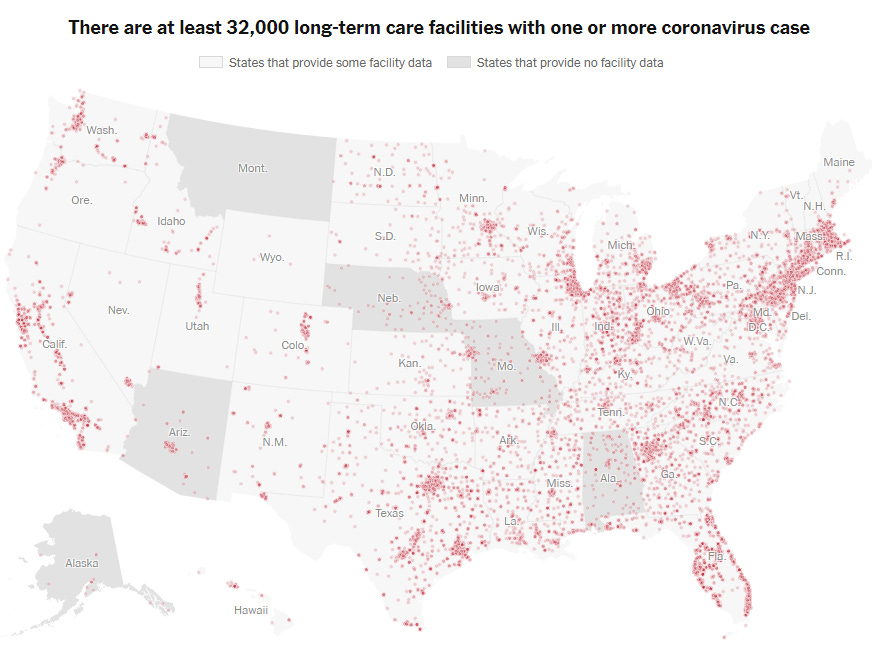These concepts of field knowledge and risk become even more important when we shift focus to the vulnerable. The Great Barrington Declaration supposes we could feasibly protect these people while cases spiked among those who were less vulnerable. What we learned in practice is that this wasn’t the case. Risk in an area where cases are high is almost always distributed throughout the community.
Let’s start with the most obvious example: nursing homes. I worked in a senior living center at the start of the pandemic, covering shifts for middle-aged coworkers who quit. We were pretty draconian to keep COVID out which took a devastating toll on our residents. I have to imagine other centers were too since letting the disease sweep through a nursing home is equivalent to a massacre. These folks knew damn well that it could kill them, as did their caregivers. And yet in basically every state, substantial numbers of them died, and in most cases they died not only in the Spring but also in the Winter when we knew so much more and were better-equipped.
If the vast majority of states were not able to figure this out, we have to conclude that keeping the virus out of a particular space is incredibly difficult if COVID is spiking exponentially in the surrounding community. We clearly did not know how to do it, and this was not only a matter of resources. A meta review by healthcare experts at Brown and Harvard found that neither facility rating nor prior success with infection control did anything to lower deaths. Many have argued that the problem with nursing homes was a systemic vulnerability that couldn’t have been spot treated. That was compounded by staffing shortages and extremely high turnover, replacing caregivers with years of experience with highschool graduates (an immense, unrecoverable loss of human capital). The result of all of this was a minimum of 32,000 nursing homes having 1+ cases and 30% of all deaths occurring within them. I encourage you to look at the following visualization and tell me if a redistribution of resources would have solved the problem.
The answer is no. We all know that public health measures are imperfect, and so I quote Dr. Stefan Baral who was at the signing of the GBD: “If interventions worked just like people theorized, public health would be easy. But public health is hard. And while many assumed masks, tests, and restrictions-based interventions would be easy wins over this terrible virus, they just weren't.” There was never any evidence that these flawed interventions could maintain zero COVID in one place despite rampant spread in the community. The data suggest that cases among the young inevitably reach the elderly (for one striking example, see below).
Attempting to re-open society when we knew this was the pattern would have been disastrous, and especially if we did so just before the winter wave. I thus agree with Rochelle Walensky and others who called it unilateral disarmament to allow cases to spike without anyone having a clear sense of how to reliably decouple them from deaths even in the most protected, isolated settings. And that’s ignoring the fact that the vast majority of elderly people live not in nursing homes but within our communities, without access to such protection. I haven’t even space to comment on the millions of Americans younger than 65 living with significant health conditions.
What makes this worse is that The Great Barrington Declaration was published in October of 2020. We were about to learn in the next 1-2 months that extremely effective vaccines were coming, which we knew for a fact would lower deaths amidst cases. We definitely should have waited, given that they were actually authorized by EUA just days before the peak of deaths for the entire year. The GBD’s publication also marked the beginning of the incredibly severe winter wave, which had everyone scrambling to find ways to to keep the health system afloat. In the midst of this chaos, was the public going to suddenly change plans and try something entirely new and risky?
Almost certainly not. I agree with Tyler Cowen who wrote that this would have been: “akin to charging the hill and taking casualties two days before the end of World War I.” And by the time the wave subsided, the elderly were either vaccinated or being offered vaccines. So the GBD was about to lose the vast majority of its relevance to policy because we would never come close to a lockdown again. Every state was effectively fully open by the Summer with relatively minor restrictions by the end of winter.







